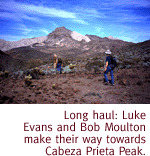
Big Guns, Bighorn And A Vast, Lonely Desert.
By Kevin Franklin
SPENT .50 CALIBER rounds litter the ground. A crumpled
aluminum tow-dart glimmers amid dark basalt boulders, and the
desert stretches as far as the eye can see.
While it may sound like the Out There reconnaissance team has
landed on the Kuwaiti frontier, we're actually in the heart of
the Cabeza Prieta National Wildlife Refuge. Our plan is to climb
Cabeza Prieta Peak, the namesake of this 860,000-acre sweep of
wild desert.
 The .50-caliber shells have been out here for decades, from the
time when the military still fired live rounds over the refuge.
The dart probably landed here after being shot down during military
target practice, back in the '60s or '70s.
The .50-caliber shells have been out here for decades, from the
time when the military still fired live rounds over the refuge.
The dart probably landed here after being shot down during military
target practice, back in the '60s or '70s.
When going onto the refuge, the U.S. Fish and Wildlife Service
requires visitors to carry a permit and sign a "hold harmless"
form. While the military doesn't fire live rounds over the refuge
anymore, every once in a while something drops from the sky. Also,
there are plenty of old munitions on the ground waiting for the
intellectually impaired to come and monkey with them. In these
litigious times, if some joker insists on blowing himself to kingdom
come, it won't be at taxpayer expense.
When I was here seven years ago hiking with a group of UA students,
one of them thought it would be a swell idea to make a bandoleer.
When air crews conducted target practice out here, they used to
clear their weapons before returning to base. When you cleared
a .50-caliber machine gun in the old planes, it would often hurl
a live round out of the aircraft and onto the ground. Thirty years
later, this student began picking up old rounds and the connecting
pieces that hold the cartridges in a string.
The bonehead started picking up live rounds. Gunpowder
can become unstable over time. If just one of those rounds on
his Pancho Villa accessory outfit went off, not only would it
have torn him to ribbons, but everyone standing around
him. Without being in a chamber, the cartridge could explode in
all directions--like a hand grenade--as I quickly informed him.
On today's hike, we're unencumbered by morons. Cabeza Prieta
Peak is not the highest point in the refuge, nor even in its own
range, but it's certainly one of the most striking. Cabeza Prieta
translates to "Dark Head," most likely due to the dark
andesite lava that erupted amid the peak's white granite. The
stark contrast is visible from many miles away.
Less apparent is the route ascending the peak--no foot trails
or signs mark the way. This is deep wilderness, and hikers are
on their own. From past experience, we know the surest way up
the 2,559-foot mountain is the eastern flank. To get there requires
a five-and-a-half-mile hike across the desert, through thick patches
of teddy-bear cholla and broken ground.
 We cross-cut through three canyons at their lowest points until
we find a shallow slope that winds up to a wide saddle separating
the peak from the rest of the range. Any kind of rock-climbing
around here can be extremely dangerous. The rocks have been exposed
to the elements for a long time, and are what climbers call "rotten."
They crumble readily in the hand and can convey a false sense
of security at crucial points.
We cross-cut through three canyons at their lowest points until
we find a shallow slope that winds up to a wide saddle separating
the peak from the rest of the range. Any kind of rock-climbing
around here can be extremely dangerous. The rocks have been exposed
to the elements for a long time, and are what climbers call "rotten."
They crumble readily in the hand and can convey a false sense
of security at crucial points.
At the saddle, the final leg to the peak is straightforward,
if not exactly easy. The mountains here aren't large, but they're
definitely steep and rugged. At several points we scramble along
knife-edge ridges that are scarcely a foot wide.
Then, from around a corner we spot several bighorn sheep. We
stop to watch them, and they stop to watch us. The longer we sit
quietly, the more sheep we spot. There are at least eight of them,
many stout rams. After giving us a thorough reading, they decide
it's time to bug out and race down the slope. They descend in
a few minutes what was more than an hours' climb for us.
We reach the peak and take in the view. The trail register at
the top goes back to the mid-'60s, and until recently, there were
very few names in it. Even now it's been months since the last
entry. We add ours to the august list and leave the mountain to
the sheep.
Next week: Riding the Devil's Highway!
Getting There
For more information, you can write to the Fish and Wildlife
Service at 1611 N. Second Ave., Ajo, Arizona 85321. Call 1-602-387-6483
to secure a free permit to enter the area.
Mapage
The Cabeza Prieta and Tule Wells 7 1/2-minute topographical maps
cover the refuge well. You may also want maps covering the length
of El Camino del Diablo, the only way to the starting area south
of the peak.

|





